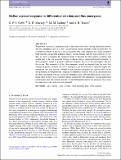Files in this item
Stellar coronal response to differential rotation and flux emergence
Item metadata
| dc.contributor.author | Gibb, Gordon Peter Samuel | |
| dc.contributor.author | Mackay, Duncan Hendry | |
| dc.contributor.author | Jardine, Moira Mary | |
| dc.contributor.author | Yeates, A. R. | |
| dc.date.accessioned | 2016-02-24T13:10:07Z | |
| dc.date.available | 2016-02-24T13:10:07Z | |
| dc.date.issued | 2016-03-11 | |
| dc.identifier | 241204702 | |
| dc.identifier | 49ddc75d-298e-4e4d-a774-df9a80cbcb51 | |
| dc.identifier | 84963831850 | |
| dc.identifier | 000372265800016 | |
| dc.identifier.citation | Gibb , G P S , Mackay , D H , Jardine , M M & Yeates , A R 2016 , ' Stellar coronal response to differential rotation and flux emergence ' , Monthly Notices of the Royal Astronomical Society , vol. 456 , no. 4 , pp. 3624-3637 . https://doi.org/10.1093/mnras/stv2920 | en |
| dc.identifier.issn | 0035-8711 | |
| dc.identifier.other | BibCode: 2016MNRAS.456.3624G | |
| dc.identifier.other | ORCID: /0000-0001-6065-8531/work/58055424 | |
| dc.identifier.other | ORCID: /0000-0002-1466-5236/work/57821818 | |
| dc.identifier.uri | https://hdl.handle.net/10023/8298 | |
| dc.description | GPSG would like to thank the STFC for financial support. DHM would like to thank the STFC and the Leverhulme Trust for financial support. Simulations were carried out on a STFC/SRIF funded UKMHD cluster at St Andrews. | en |
| dc.description.abstract | We perform a numerical parameter study to determine what effect varying differential rotation and flux emergence has on a star's non-potential coronal magnetic field. In particular we consider the effects on the star's surface magnetic flux, open magnetic flux, mean azimuthal field strength, coronal free magnetic energy, coronal heating and flux rope eruptions. To do this, we apply a magnetic flux transport model to describe the photospheric evolution, and couple this to the non-potential coronal evolution using a magnetofrictional technique. A flux emergence model is applied to add new magnetic flux on to the photosphere and into the corona. The parameters of this flux emergence model are derived from the solar flux emergence profile, however the rate of emergence can be increased to represent higher flux emergence rates than the Sun's. Overall we find that flux emergence has a greater effect on the non-potential coronal properties compared to differential rotation, with all the aforementioned properties increasing with increasing flux emergence rate. Although differential rotation has a lesser effect on the overall coronal properties compared to flux emergence, varying differential rotation does alter the coronal structure. As the differential rotation rate increases, the corona becomes more open, and more non-potential. | |
| dc.format.extent | 14 | |
| dc.format.extent | 5726964 | |
| dc.language.iso | eng | |
| dc.relation.ispartof | Monthly Notices of the Royal Astronomical Society | en |
| dc.subject | Stars: activity - stars: coronae | en |
| dc.subject | Stars: magnetic field | en |
| dc.subject | Stars: rotation | en |
| dc.subject | QB Astronomy | en |
| dc.subject | QC Physics | en |
| dc.subject | NDAS | en |
| dc.subject.lcc | QB | en |
| dc.subject.lcc | QC | en |
| dc.title | Stellar coronal response to differential rotation and flux emergence | en |
| dc.type | Journal article | en |
| dc.contributor.sponsor | Science & Technology Facilities Council | en |
| dc.contributor.institution | University of St Andrews. Applied Mathematics | en |
| dc.contributor.institution | University of St Andrews. School of Physics and Astronomy | en |
| dc.identifier.doi | https://doi.org/10.1093/mnras/stv2920 | |
| dc.description.status | Peer reviewed | en |
| dc.identifier.url | http://adsabs.harvard.edu/abs/2016MNRAS.456.3624G | en |
| dc.identifier.grantnumber | ST/M001296/1 | en |
This item appears in the following Collection(s)
Items in the St Andrews Research Repository are protected by copyright, with all rights reserved, unless otherwise indicated.

